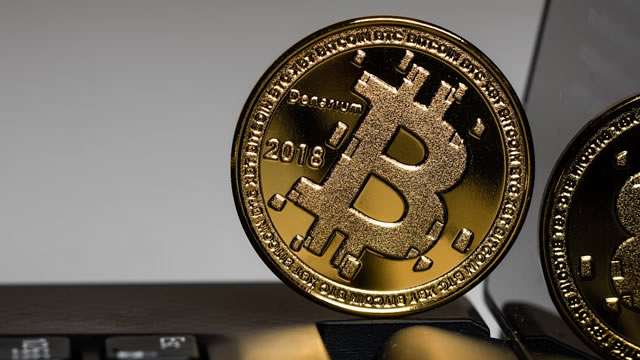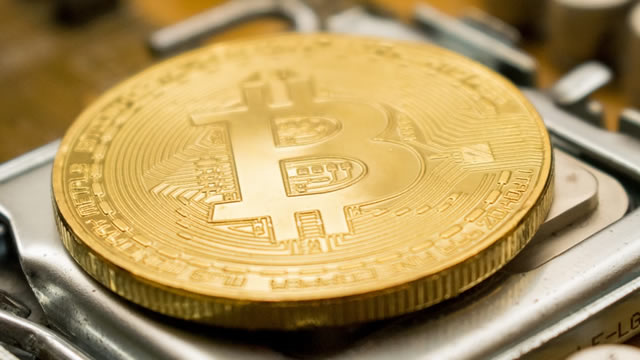Language
- English
- Română
Currency
- $ USD
- € EUR
Bitcoin Struggles to Hold Gains as Price Eyes $80K Support

More News Articles
Bitcoin (BTC) Jumps To $82,000 As Trump Announces 90-Day Pause On Tariffs Except China
Crypto and stock prices have surged in the past hour after US President Donald Trump announced a 90-day pause for tariffs on multiple nations, except China. Bitcoin (BTC), the flagship crypto, now eyes the $83,000 barrier after jumping 6.1% following the news.
Bitcoin, Blockchains, Tokenization Form The Core Of New Global Financial Infrastructure: Bernstein
As global trust in centralized institutions frays, analysts at Bernstein say three foundational decentralized technologies — Bitcoin (CRYPTO: BTC), public blockchains and tokenized assets — are poised to become integral to a new financial order. What Happened: In its report, Bernstein's digital assets team argues that the combination of geopolitical realignment, trade conflicts and financial system fragmentation is accelerating the adoption of decentralized technologies across sovereign and institutional actors.
Trump Administration Wants Weaker Dollar and That's Positive for Bitcoin: Bitwise
The asset manager said it was sticking to its 2025 year-end bitcoin price target of $200,000.
Kaiko Q1 report: Bitcoin retains liquidity, Ethereum and altcoins lost market depth
In Q1, the crypto market erased the effect of the US elections. BTC retained its market depth, but Ethereum (ETH) and altcoins lost around 30% of their liquidity on average.
China and Russia settle energy trades in Bitcoin, VanEck confirms
China and Russia are now reportedly settling select energy transactions using Bitcoin, according to a recent report by investment firm VanEck. The move marks a shift away from the U.S.
Bitcoin Hits $82,000 As President Trump Announces 90-Day Pause On Reciprocal Tariffs For All Countries But China
Bitcoin (CRYPTO: BTC) on Wednesday crossed the $82,000 mark, following a significant short squeeze that liquidated $75 million in bearish bets within a span of one hour. The apex crypto Bitcoin made a high of $82,450 according to TradingView data after President Trump's announcement that the U.S. would raise tariffs on China to 125%, effective immediately, but pause reciprocal tariffs on 75 countries for 90 days.
Bitcoin surges 8% in broad market relief rally as Trump pauses some tariffs
Watch Daily: Monday - Friday, 3 PM ET
Bitcoin rips to $82k after Trump's 90-day pause on tariffs catalyze bullish sentiment
Bitcoin (BTC) soared back above $82,000 on April 9 after President Donald Trump announced that his administration would pause tariffs on most nations for 90 days, igniting a broad rally in global markets after a bloody week.
Trump's 90-day tariff pause sends bitcoin back to $81,000
Bitcoin and equities surged as President Trump increased tariffs on China and paused duties on other countries for 90 days.
Bitcoin Bounces Back To $81k As Trump Eases Global Tariffs
China's tariffs remain in place, however, and have been increased to 125%.
Bitcoin ‘significantly de-risked here' as nearly 80% of cyclical price correction is done — Analyst
Bitcoin's (BTC) futures market reflects a possible price cooldown after the cryptocurrency's multiple weeks of correction. Data from CryptoQuant indicated that the BTC-USDT futures leverage ratio with respect to open interest (OI) has halved since peaking in early 2025.
China Hits Back With 84% Tariffs on U.S. Goods, Bitcoin Drops to $76K
China tariffs surge to 84% in retaliation for U.S. duties, leading to renewed fears of a prolonged trade war. Bitcoin plunged below $76K as investors reacted to the mounting economic uncertainty. The post China Hits Back With 84% Tariffs on U.S. Goods, Bitcoin Drops to $76K appeared first on Cryptonews.
Bitcoin Blazes Past $82K as Wall Street Roars on Trump's 90-Day Tariff Timeout
Wall Street rebounded sharply on April 9 after President Donald Trump announced a 90-day pause on tariffs, temporarily easing trade tensions. Bitcoin roared past the $82,000 range at 1:50 p.m. Eastern Time on Wednesday. Trump's Temporary Tariff Freeze Lifts Wall Street and Crypto The S&P 500 jumped over 7.
Quant Analyst PlanB Says Bitcoin Correction ‘Normal Bull Market Dip' After 30% Drop for BTC
Widely followed on-chain analyst PlanB says that Bitcoin's (BTC) current correction is part and parcel of regular bull market conditions. The pseudonymous analyst tells his 2.1 million followers on the social media platform X that the indicators he watches are still signaling bullishness for the flagship crypto asset.
Bitcoin In Free Fall: Michael Saylor's Enigmatic Tweet
In the face of the recent plunge of bitcoin below the $75,000 mark, Michael Saylor, president of MicroStrategy's strategy, needed just one word to reaffirm his position: "HODL." This emblematic term of the crypto community perfectly summarizes the businessman's philosophy.
Bitcoin approaches critical $63K support: What happens next?
Is Bitcoin all set to finally revisit price levels from four years prior?
Breaking Bitcoin News: Germany Set to End Bitcoin's Tax-Free Holding Period as SPD Takes Over
According to reports from Berlin, the SPD (Social Democratic Party) is expected to head the finance ministry in the upcoming government—bringing with it significant changes to how crypto is taxed.
Bitcoin Jumps 6% to $81K as Crypto Prices Surge on Trump's Tariff Pause
President Trump said he authorized a 90-day pause on tariffs on countries that haven't retaliated against the U.S.
BTC Price Blasts Past $80k As Trump Announces 90-Day Pause On Reciprocal Tariffs
The price of Bitcoin (BTC) has blasted past the resistance level at $80,000 after US President Donald Trump announced a 90-day pause on his reciprocal tariff measures. The price of the coin has faced series of rejection at this point following the trade war escalation with China.
Breaking: Bitcoin Soars 5% on Tariff Reversal
The price of Bitcoin, the leading cryptocurrency by market capitalization, has surged by roughly 5%, reaching an intraday high of $81,798 on the Bitstamp exchange.
BREAKING: Bitcoin reclaims $81K amid tariff pause, China still hit with 125% rate
Bitcoin reclaimed the $80,000 level while major U.S. stock indices soared higher after President Donald Trump announced a temporary pause on the administration's tariff regime for some countries.
Bitcoin, XRP and Stocks Surge as Trump Confirms 90-Day Pause on Tariffs—Except on China
Crypto and stock prices alike are skyrocketing after President Trump confirmed that he has authorized a pause on most trade tariffs.
Kalshi accepts Bitcoin deposits in bid to woo crypto-native users
Prediction marketplace Kalshi has started taking Bitcoin (BTC) deposits in a bid to onboard more crypto-native users.The company that lets users bet on events ranging from election outcomes to Rotten Tomatoes film ratings has seen a strong uptake among crypto traders, Kalshi told Cointelegraph on April 9. For instance, event contracts for betting on Bitcoin's hour-by-hour price changes have seen $143 million in trading volume to date, a spokesperson said.
The U.S. Tariff War With China Is Good For Bitcoin Mining
Bitcoin Magazine The U.S. Tariff War With China Is Good For Bitcoin Mining President Trump's tariffs will make it more expensive for American mining companies to import ASICs — and this is a good thing. This post The U.S. Tariff War With China Is Good For Bitcoin Mining first appeared on Bitcoin Magazine and is written by Frank Corva.
Price analysis 4/9: BTC, ETH, XRP, BNB, SOL, DOGE, ADA, LEO, LINK, TON
Risky assets remain volatile as trade war tension between the United States and China keeps investors on the edge. A minor positive is that Bitcoin (BTC) has avoided a sharp fall and is trading well above the crucial near-term support at $73,777.
China and Russia are using Bitcoin to settle energy trades
China and Russia are now using Bitcoin to pay for energy deals, according to VanEck. This comes as Donald Trump hits China and the EU with new tariffs, announced on April 2, sending Bitcoin briefly down from $85,000 to $81,000.
Big Players Actively Accumulate Bitcoin Amid Market Turmoil – On-Chain Metrics
Bitcoin is currently undergoing one of the most aggressive corrections ever seen during a bull market — not just in terms of price but also in investor sentiment. While BTC remains technically in a long-term uptrend, the emotional toll on the market tells a different story.
Bitcoin Stands To Win If Trump Tanks The Dollar, Bitwise Says
In a newly released investor note, Bitwise Chief Investment Officer (CIO) Matt Hougan argues that Bitcoin stands to benefit significantly from the Trump administration's push toward a weaker dollar—even if that push risks ending the dollar's long standing role as the world's reserve currency.
Pakistan to Use Surplus Electricity for Bitcoin Mining and AI Data Centers: Report
Bitcoin Magazine Pakistan to Use Surplus Electricity for Bitcoin Mining and AI Data Centers: Report Pakistan reportedly announced plans to allocate excess power to Bitcoin mining and AI infrastructure, just days after appointing Binance founder Changpeng Zhao as strategic crypto advisor. This post Pakistan to Use Surplus Electricity for Bitcoin Mining and AI Data Centers: Report first appeared on Bitcoin Magazine and is written by Nik.
Bitcoin sell-off puts mid-term holders under pressure: Glassnode
Bitcoin's downside pressure has seen sell-off dynamics shift from newer coins to older cohorts, with the gradual capitulation coming amid broader market weakness.
Bitcoin tests November lows, altcoins slump with HYPE leading daily gains
As Bitcoin struggled near key support, analysts shared mixed signals. Altcoins, remained in the red across the board.
Bitcoin Is Needed To Raise Funds In Myanmar For Earthquake Relief
Bitcoin offers a unique symbol of hope - and a way to get help directly to those suffering from one of the most devastating earthquakes in human history.
Bitcoin DeFi Network Arch Finds VC Backer for Early-Stage Projects
Arch Network is working with DPI Capital to write first checks for "pillar" protocols building on the Bitcoin DeFi project.
Bitcoin has 'fully decoupled' despite tariff turmoil, says Adam Back
As markets reel from geopolitical tensions and economic uncertainty, Bitcoin has shown relative resilience during events like Trump's recent tariff bombshells, according to Blockstream CEO Adam Back.While in the short term, Bitcoin (BTC) may move in tandem with stocks and other risk-on assets, Back sees the long-term trend telling a different story. “Bitcoin is fully decoupled because it's gone up five or six times since the bottom of the market three years ago,” he said during an exclusive interview with Cointelegraph at Paris Blockchain Week.
MicroStrategy in Big Trouble? As Bitcoin Price 10% Away From Liquidation Threat
Bitcoin's recent price swings have always been a hot topic, and this time, all eyes are on MicroStrategy and its co-founder, Michael Saylor. With Bitcoin slipping below $75,000, concerns are growing that MicroStrategy might be forced to sell its massive Bitcoin holdings to avoid liquidation.
BofA's blunder: How bitcoin turned a ‘crash' into a 1,000% surge
When it comes to whether bitcoin is (or was ever) a bubble, the late John McAfee said it best.
Bitcoin Trades Sideways as US – China Trade War Commences
Both traditional assets and the leading cryptocurrency seem to be trading mostly sideways in the midst of economic uncertainty as the world's two largest economies duke it out. BTC Stalls Amid Escalating U.S.
Saylor says ‘HODL' as Strategy stirs speculation with $700M Bitcoin move amid market volatility
Bitcoin-heavyweight Strategy, formerly known as MicroStrategy, has moved over 8,000 BTC (more than $700 million) to four newly identified wallets, according to data from blockchain analytics platform Arkham Intelligence. On-chain data from Arkham Intelligence shows the transfers occurred across four transactions between April 2 and April 5.
Trump Tariff Winners? Bitcoin And Gold, Bitwise's Matt Hougan Says
Matt Hougan, Chief Investment Officer at Bitwise Asset Management, says the United States' evolving stance on the dollar's global reserve role could trigger a structural shift in the financial system, one that favors alternative stores of value like Bitcoin (CRYPTO: BTC) and gold. What Happened: In a new blog post titled “The Fallout From Trump's Tariff Push”, Hougan responded to recent U.S. policy developments, including the White House's aggressive push for tariffs and comments from top economic officials suggesting a deliberate move toward a weaker dollar.
Zettahash on the Horizon: Bitcoin's Hashrate Nears 1 ZH/s as Miners Face Squeeze
As bitcoin's valuation languishes near its weakest point since last year—with hashprice, the projected daily earnings for one petahash per second (PH/s) of mining capacity, receding to $40—the network's computational muscle has paradoxically swelled to a historic peak.
Investors Pull $326 Million From Bitcoin ETFs Amid Tariff Angst
Tuesday's drawdown was the most pronounced pullback in nearly a month.
Bitcoin Price News: Investors Take $600M Out of ETFs – Is BTC Going to $60K?
Investors have withdrawn $594 million out of Bitcoin exchange-traded funds in the past four days as President Trump's tariff increases have rattled market participants.
Analysts Warn Of Dark Times Ahead For Bitcoin
Bitcoin is facing increasing pressure since the resurgence of the trade war initiated by Donald Trump. While many hoped to see the asset detach from the influence of Wall Street, reality is catching up with the markets: the rise in U.S. bond yields is dampening initial enthusiasm.
Michael Saylor's Strategy May Need to Sell BTC at a Loss To Cover Debt, What Does This Mean For the Bitcoin Price?
Michael Saylor's Strategy faces mounting pressure to sell Bitcoin reserves at a loss to cover debt obligations, raising questions about the impact on Bitcoin's price and the firm's long-term crypto strategy. The post Michael Saylor's Strategy May Need to Sell BTC at a Loss To Cover Debt, What Does This Mean For the Bitcoin Price? appeared first on Cryptonews.
Trade war chaos could spark a Bitcoin rally – Find out why
Is Bitcoin on the brink of a major rally despite short-term market swings?
Crypto Analyst: 33% Chance Bitcoin Already Topped—Brace For $52,000
Veteran crypto analyst Bob Loukas has reduced his Bitcoin exposure, warning followers that while the bull cycle remains intact, the probability that Bitcoin has already peaked for this four-year cycle has materially increased. In an update published April 8th, Loukas detailed the rationale behind selling one-third of his model portfolio at $79,500, citing both technical deterioration and a worsening macroeconomic backdrop.
BTC volatility over the past week is slightly above yearly average: K33
When looking at data throughout the market, it's fairly easy to find some bright spots right now.
Bitcoin Could Mirror 2020 Crash-and-Rebound Pattern, CoinShares Analyst Warns
Bitcoin's recent drop amid Trump-China tariff tensions mirrors its 2020 crash-and-rebound pattern, with analysts suggesting macroeconomic shocks could set the stage for another recovery fueled by monetary policy shifts and investor optimism. The post Bitcoin Could Mirror 2020 Crash-and-Rebound Pattern, CoinShares Analyst Warns appeared first on Cryptonews.



































































